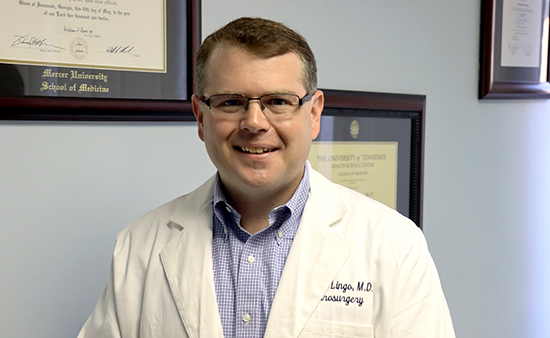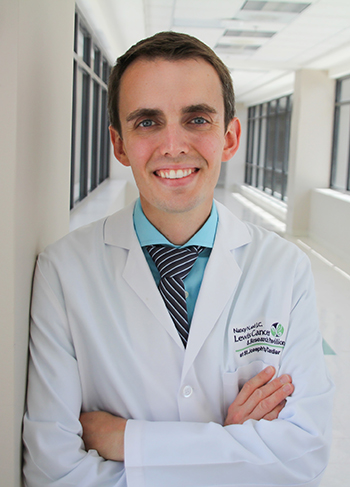Treating brain cancer close to home
Cancer
Using the latest technology, our physicians are able to treat both benign and cancerous tumors at our Savannah, Bluffton and Hilton Head locations
Learning you have a brain tumor, whether benign or malignant, is a terrifying thing. For patients in the Savannah region and Lowcountry of South Carolina, one comforting thought is that you don’t have to go far for treatment.
“If you get diagnosed with a brain tumor, that’s one of the most stressful things you can go through. You want to be close to your family, your social support network,” says Dr. P. Ryan Lingo, board-certified neurosurgeon with the Neurosurgical & Spine Institute. 
“There’s really not much that our community can’t handle when it comes to brain tumors. We get wonderful outcomes. We have the latest technology. We have a group of very dedicated, passionate and skilled physicians and surgeons to care for you.”
Dr. Lingo is part of the Nancy N. and J.C. Lewis Cancer & Research Pavilion’s brain tumor conference board. He, along with radiation oncologists, medical oncologists, nurses and others, meet regularly to discuss individual patient cases to determine the best course of treatment.
Treating brain tumors is highly specific to the pathology, location, size of the tumor and any symptoms you experience, Dr Lingo says. Therefore, not every person needs the same treatment, even if it’s the same type of tumor or in the same location.
“We have radiation oncologists, medical oncologists and surgeons that work together very closely to formulate individual treatment plans for patients,” Dr. Lingo says. “It’s a very collegial environment, and I think it results in better outcomes for patients.”
Ways to treat brain tumors
At St. Joseph’s/Candler and the LCRP, we are capable of treating both benign and malignant brain tumors, whether it’s a primary brain tumor (the cancer originated in the brain) or metastatic (the cancer originated elsewhere in the body).
Related Article: What are the signs of a brain tumor?
For benign brain tumors, such as meningiomas, pituitary adenomas or vestibular schwannomas, treatment depends on the size and symptoms. If it’s small and not causing any problems, your healthcare team may recommend observation or conservative management. This would include repeat MRIs within six months to a year to monitor for growth.
For larger, more symptomatic benign brain tumors, especially that are in difficult spots to remove surgically, your healthcare team may recommend radiation therapy on either the TrueBeam® or CyberKnife® machines available at the LCRP. (TrueBeam® is also available in Bluffton.)
Related Article: How CyberKnife® technology is helping patients with non-cancerous conditions
Radiation therapy also may be recommended for malignant brain tumors using either the TrueBeam® or CyberKnife®.

“TrueBeam® or CyberKnife® are both good options in the right scenario,” says Dr. Stephen Ramey, radiation oncologist at the LCRP. “With CyberKnife®, we are usually treating relatively small tumors. For TrueBeam®, both small and larger tumors can be treated. There are certain tumor types that we know will be treated on TrueBeam® because they need fractionated radiation over a longer course of time, like five or six weeks.”
“There’s not really any tumor type that we can’t treat with radiation here between CyberKnife® and TrueBeam®.”
Radiation therapy for brain tumors may be the only treatment method you need or it may be in conjunction with surgery and occasionally chemotherapy. Depending on your radiation therapy course of treatment, It can cause some side effects. Mostly commonly patients experience fatigue, headaches, nausea, vomiting, numbness or weakness, Dr. Ramey says.
“We’ve made dramatic improvements over the last five or 10 years in what we can do for brain cancer,” says Dr. Ramey. “We have become much more focal with the radiation treatment. That has led to fewer side effects by being able to be more precise with the radiation and using a smaller margin around the treated area because we’ve gotten such great improvements in our technology.”
Additionally, once patients are done with treatment, Dr. Ramey says most are grateful they were able to stay close to home.
“I think they are very happy we have such a great cancer center and advanced technology here to be able to treat them in Savannah or Bluffton,” Dr. Ramey says. “It’s really nice to be able to treat a variety of different types of tumors and issues close to home for our patients.”
Surgery options for brain tumors
For larger, more symptomatic tumors, most patients will need surgery to biopsy and/or remove as much of the tumor as possible. That’s where Dr. Lingo’s expertise comes into play. He has a special interest and fellowship training in treating brain and skull-based tumors and is in surgery several times a week specifically resecting brain tumors.
There are many advanced techniques and technologies in brain surgery that Dr. Lingo can do right here at St. Joseph’s/Candler that “makes it safe and highly effective,” Dr. Lingo says. Let’s take a look at some of those surgical options.
- The neurosurgical community has adapted the use of operating microscopes that are very high-powered so the surgeon can magnify the brain. This allows them to do small, delicate surgery on the brain and separate tumors from the brain, Dr. Lingo describes.
- Additionally, they can add special filters to these microscopes that can make certain tumors glow in the dark so they are more visible to the surgeon. They glow pink, and that helps the surgeon differentiate between the tumor and normal brain. This method is called fluorescence guided surgery.
- Another surgical technique is called intraoperative neuronavigation. Using computer-assisted technology, the surgeon can navigate within the skull using diagnostic images, such as MRIs, to create a three-dimensional view of your brain. This helps surgeons plan for surgery or alleviate the extent of resection of tumors. It also helps surgeons stay away from “danger zones” that could cause permanent damage to the patient if harmed.
“It’s almost like GPS for surgery,” Dr. Lingo says. “It’s a very powerful tool we have here.” - Another type of surgery is called Minimally Invasive Parafascicular Surgery, or MIPS. This method uses special retractors shaped like small cylindrical tubes to locate the tumor and not disrupt any healthy tissue that may be overlying the tumor. This is especially used when tumors are located deeper in the brain. Dr. Lingo says this is a relatively newer technology that has worked well, especially in treating metastatic tumors.
- Neurosurgeons also utilize specialized neuromonitoring during a lot of surgical procedures, Dr. Lingo says. There’s an experienced team of neuromonitoring SJ/C co-workers that help the surgeon localize special and unique areas of the brain that are responsible for certain tasks. Those are called eloquent areas of the brain, such as the strip of the brain that controls the movement on the opposite side of your body. That is something very critical in localizing during surgery so you can protect it, Dr. Lingo says. Or, sometimes if the tumor is located in or around the speech areas of your brain, the team can map these during surgery by talking to the patient, which stimulates the brain and identifies those areas to protect during surgery.
“You can see how the treatment of brain tumors is really nuanced and why we put so much thought into each patient’s individualized treatment plan,” Dr. Lingo says. “And, I think it’s tremendous that it can all be done close to home.”